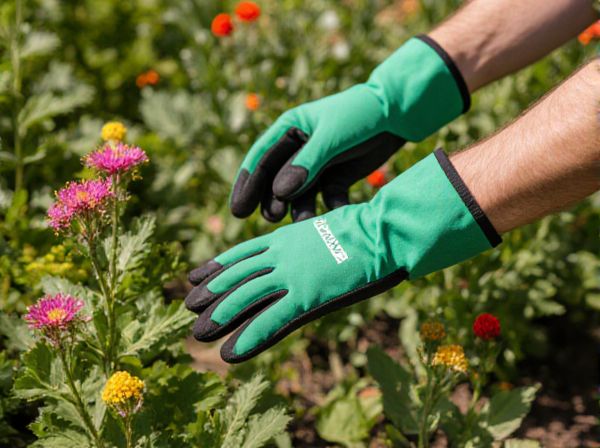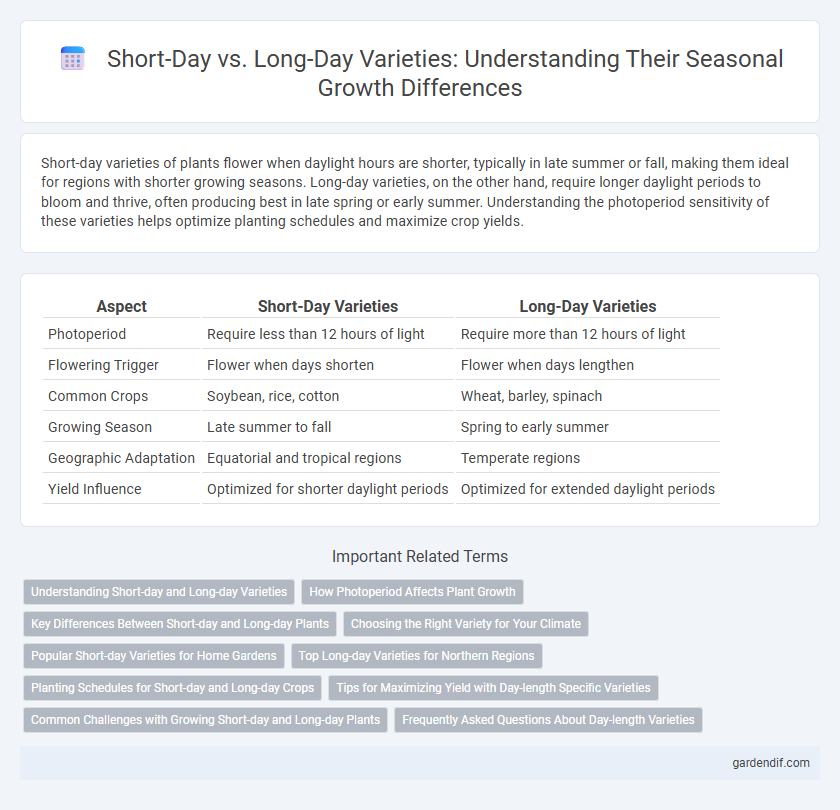
Short-day varieties vs Long-day varieties Illustration
Short-day varieties of plants flower when daylight hours are shorter, typically in late summer or fall, making them ideal for regions with shorter growing seasons. Long-day varieties, on the other hand, require longer daylight periods to bloom and thrive, often producing best in late spring or early summer. Understanding the photoperiod sensitivity of these varieties helps optimize planting schedules and maximize crop yields.
Table of Comparison
| Aspect | Short-Day Varieties | Long-Day Varieties |
|---|---|---|
| Photoperiod | Require less than 12 hours of light | Require more than 12 hours of light |
| Flowering Trigger | Flower when days shorten | Flower when days lengthen |
| Common Crops | Soybean, rice, cotton | Wheat, barley, spinach |
| Growing Season | Late summer to fall | Spring to early summer |
| Geographic Adaptation | Equatorial and tropical regions | Temperate regions |
| Yield Influence | Optimized for shorter daylight periods | Optimized for extended daylight periods |
Understanding Short-day and Long-day Varieties
Short-day varieties require less than 12 hours of daylight to initiate flowering, making them ideal for planting in late summer or fall when days are shorter. Long-day varieties need more than 14 hours of daylight to flower, thriving best during late spring or early summer with extended daylight exposure. Understanding the photoperiod sensitivity of crops like soybeans, wheat, and spinach helps optimize planting schedules and improve yield based on seasonal day length variations.
How Photoperiod Affects Plant Growth
Photoperiod significantly influences plant growth by regulating flowering and developmental stages in short-day and long-day varieties. Short-day plants initiate flowering when daylight falls below a critical threshold, typically under 12 hours, while long-day plants flower when daylight exceeds this period. This photoperiod sensitivity ensures optimal seasonal adaptation, enabling crops like soybeans and chrysanthemums to thrive during specific growth cycles.
Key Differences Between Short-day and Long-day Plants
Short-day plants require less than 12 hours of daylight to initiate flowering, commonly thriving in fall or winter seasons, while long-day plants need more than 12 hours of daylight, typically flowering in the spring or early summer. The photoperiod sensitivity in short-day varieties triggers flowering when daylight decreases below a critical length, whereas long-day varieties flower when daylight exceeds this threshold. These differences influence agricultural planning, crop selection, and yield optimization based on regional day length and seasonal variations.
Choosing the Right Variety for Your Climate
Short-day varieties thrive in regions with shorter daylight hours and are ideal for planting in late summer or early fall, while long-day varieties require extended daylight periods typical of spring and early summer planting. Selecting the appropriate variety based on local photoperiod patterns ensures optimal growth, flowering, and yield performance. Understanding the specific day length sensitivity of crops like lettuce, spinach, and certain onions helps align planting schedules with seasonal light conditions for maximum productivity.
Popular Short-day Varieties for Home Gardens
Popular short-day varieties for home gardens include sweet potatoes, chrysanthemums, and certain lettuce types, which thrive when daylight is less than 12 hours. These crops initiate flowering and tuber formation during shorter daylight periods, making them ideal for planting in late summer or early fall. Choosing short-day plants ensures successful growth and abundant yields in regions with early sunset times.
Top Long-day Varieties for Northern Regions
Top long-day varieties for northern regions thrive with extended daylight hours during summer, promoting robust flowering and higher yields. Popular long-day crops like lettuce, spinach, and barley are genetically adapted to initiate flowering when day length exceeds 14 hours. Selecting these varieties ensures optimal growth and productivity in areas with long summer days and shorter growing seasons.
Planting Schedules for Short-day and Long-day Crops
Short-day varieties require planting schedules timed so flowering occurs as daylight decreases, typically in late summer or early fall. Long-day varieties thrive when planted to flower during increasing daylight hours, often in spring or early summer. Optimizing planting dates based on photoperiod sensitivity maximizes yield and crop quality for both short-day and long-day plants.
Tips for Maximizing Yield with Day-length Specific Varieties
Short-day varieties thrive when daylight hours are fewer than 12, triggering flowering and optimizing yield in late summer or fall. Long-day varieties require more than 14 hours of daylight to flower, making them ideal for spring or early summer planting in higher latitudes. Selecting the right variety based on local photoperiod and adjusting planting dates to match these day lengths maximizes crop production and resource efficiency.
Common Challenges with Growing Short-day and Long-day Plants
Short-day varieties often face challenges such as insufficient light duration in regions with longer daylight, leading to delayed flowering and reduced yield. Long-day varieties struggle with shorter natural daylight periods in certain seasons, which can inhibit growth and cause poor crop performance. Managing photoperiod sensitivity and optimizing artificial lighting conditions are critical to overcoming these common challenges in cultivating both short-day and long-day plants.
Frequently Asked Questions About Day-length Varieties
Short-day varieties flower when daylight lasts less than 12 hours, making them ideal for regions with shorter growing seasons or autumn planting. Long-day varieties require more than 14 hours of daylight to initiate flowering, thriving in climates with extended daylight during spring or early summer. Understanding day-length sensitivity helps gardeners select appropriate crops for optimal growth and yield.
Short-day varieties vs Long-day varieties Infographic

 gardendif.com
gardendif.com